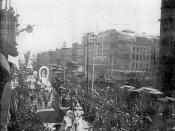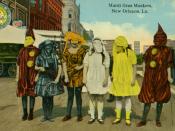When most think of Mardi Gras, they think of New Orleans, bourbon street, masses of people, and a fun filled weekend, but most do not go as far as to research the history. Mardi Gras came to New Orleans through its French heritage in 1699. Mardi Gras had been celebrated in Paris since the Middle Ages, where it was a major holiday. Iberville, a French explorer, sailed into the Gulf of Mexico, from where he launched an expedition up the Mississippi River. On March 3 of 1699, Iberville had set up a camp on the west bank of the river about 60 miles south of where New Orleans is today. This was the day Mardi Gras was being celebrated in France. In honor of this important day, Iberville named the site Point du Mardi Gras, and in turn, Mardi Gras was often celebrated on the banks of the Mississippi. Throughout the years, Orleanians have added to the celebration by establishing krewes (organizations) which host parades and balls.
The Mardi Gras season begins on January 6 and continues until Fat Tuesday, the day before Ash Wednesday. On the Christian calendar, the twelfth day after Christmas is known as "Epiphany", "Twelfth Night", or "Kings Day." It is the day the gift-bearing Magi visited the baby Jesus, and is celebrated with its own unique rituals.
Mardi has 3 different colors that all represent something related to the holiday. The colors are purple, green and gold, are all in different ways, significant to the holiday. These colors were chosen in 1872 by the King of Carnival, Rex. He chose the colors to stand for justice faith, and power; green represents faith, gold represents power, and purple represents justice. The history of Mardi gras is in turn a good depiction of our country today...


